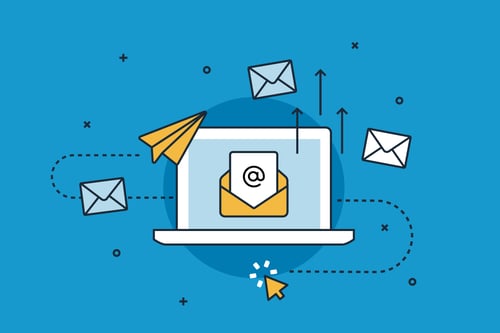The Ultimate Guide To Email Marketing For Events
Email marketing is a fantastic way to engage with attendees and get them excited about your event. It can also have a high payoff, with an average $42 return on investment (ROI) per dollar spent.
In this article, we’ll break down the best email marketing practices so you get the greatest value every time you press send. 
1. Start With Strong Subject Lines
All great emails start with great subject lines. If you have a weak or boring subject line, no one is going to open your email.
Subject lines between 6-10 words have the highest open rates, so aim for something in that range.
In order to entice users to open your emails, try the following methods:
- Ask questions. People are drawn to questions because their brain automatically wants to find an answer. Try subject lines like, “Will we see you this Friday?” to pique their interest.
- Put them on a deadline. People are generally afraid of missing out on a good deal. Encourage them to register for an event you're exhibiting at with subject lines like: “Don’t miss X at X event.”
- Include a numbered list. Placing numbers in your subject line is a great way to get people to click. The numbered list approach tells them exactly what they’re going to get. Here’s an example: “Top 5 reasons to attend XX event”
2. Use Photos and Videos
Visual media makes your emails more appealing to viewers, and increases the chances of them interacting with your content.
Be sure your images and videos are high-quality. Try sharing images from a prior event if the event has happened before. If it’s a brand new event, or your first time attending, show images that tease what attendees can expect.
For instance, if you have an exhibit at the event, create a behind the scenes video of building the exhibit. Or include photos of merchandise and swag that attendees can expect to see.
Always add alt-text to your email images. Alt-text describes the content of a photo for visually impaired people.
3. Create Clickable Buttons
In email marketing, your call to action (CTA) lies primarily in your button text. Buttons allow users to click and perform an action.
You want your button text to be as compelling as possible. Buttons that say “download”, “shop now”, or “click here” are widely overused in marketing. Instead, create button text that presents value to the user.
Great button text incorporates action verbs and second-person pronouns. For example “Grab your discount.” This uses the action verb “grab” and also “your” to help the user feel like you’re talking directly to them.
Users should know exactly what will happen when they click a button. Surprises will cause users to be upset and feel like they wasted their time. This may cause them to unsubscribe from your mailing list.
4. Test Your Emails With A/B Testing
A/B testing is an invaluable tool in email marketing. It will help you narrow down what’s working with your audience and what’s not.
In order to A/B test effectively, you have to isolate one variable in your email. For instance, change either the subject line, email image, or button text, but not all three. Changing more than one variable will make it too challenging to know what really drove engagement.
Once you do A/B tests, you’ll have a greater understanding of what your audience likes in emails. Maybe you’ll discover that your audience loves questions in subject lines, or images from past events. This information will be valuable as you continue to promote events through email.
5. Keep It Up After Your Event
Your post-event email marketing strategy is just as important as your pre-event strategy, if not moreso. The emails you send after the event will help you determine the success of the event.
Emails sent after events are also often the first impression of many attendees who signed up for your email list in person.
Be sure to send a thank you email, thanking them for attending the event and stopping by your brand experience. This is a great time to grab new customers by offering a discount code that expires a couple weeks after the event.
Next, send a follow-up survey that asks how attendees enjoyed your event, and how your brand might improve next time. Finally, make sure you provide useful content like videos of speakers attendees might have missed, or blog posts that summarize the event.
We Build Brand Experiences Worth Emailing About
At Hamilton, we create immersive brand experiences, both in-person and virtual, that you’ll be pleased to share via email.
Contact us today to learn more about how we can help with your next trade show, corporate event, or conference.

